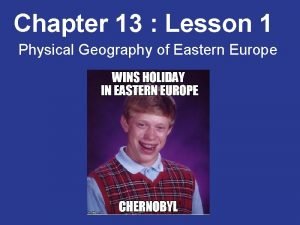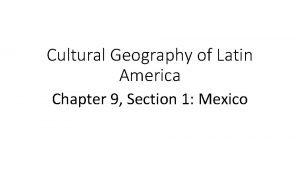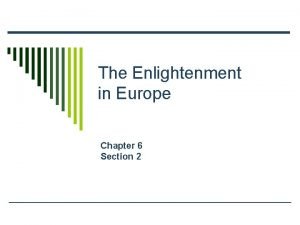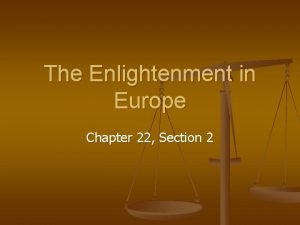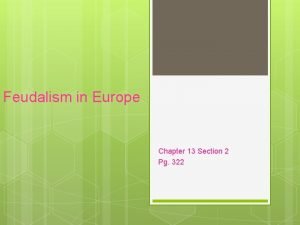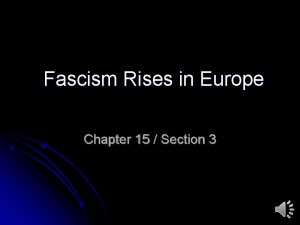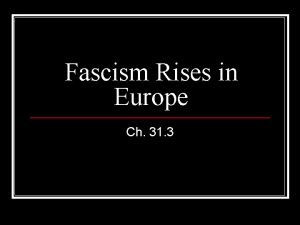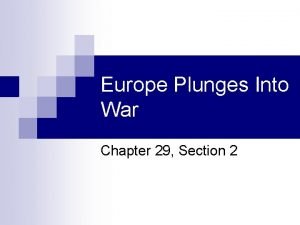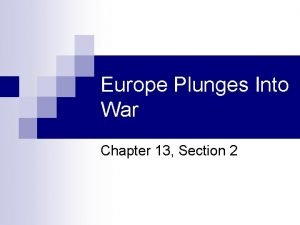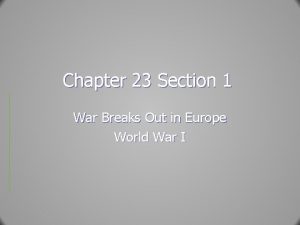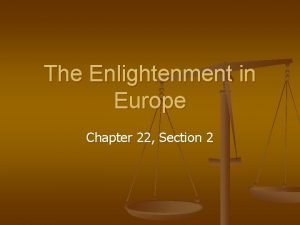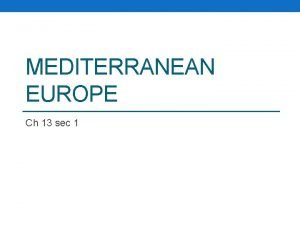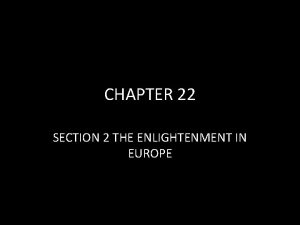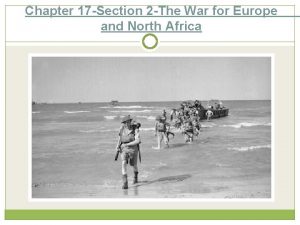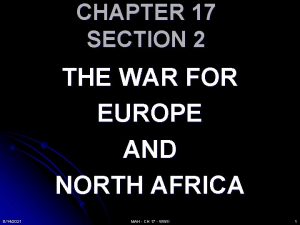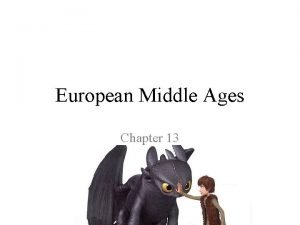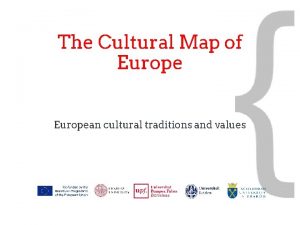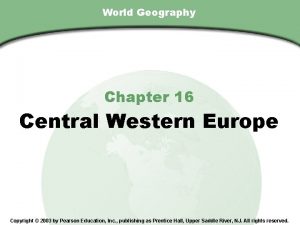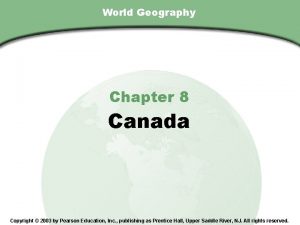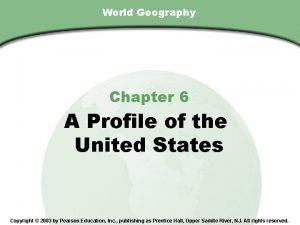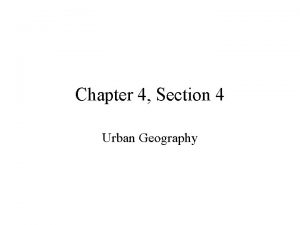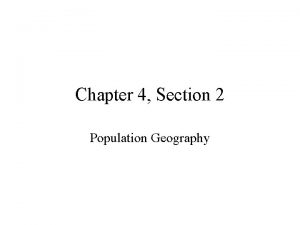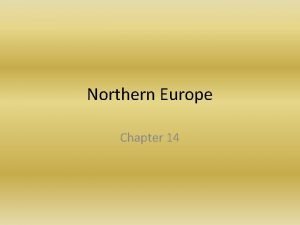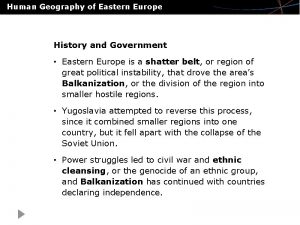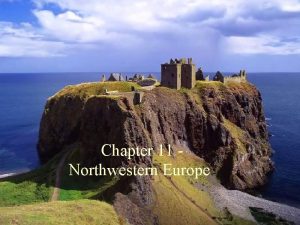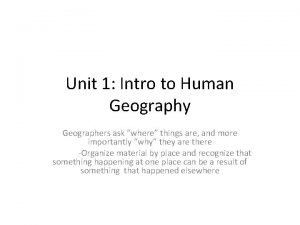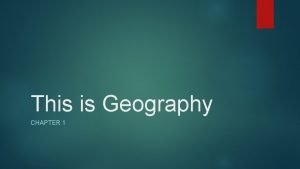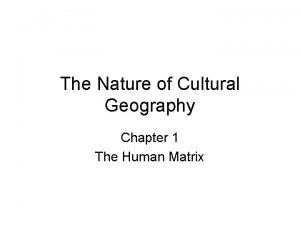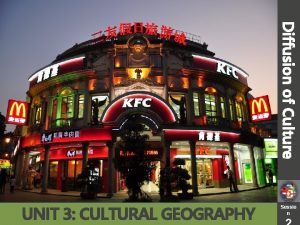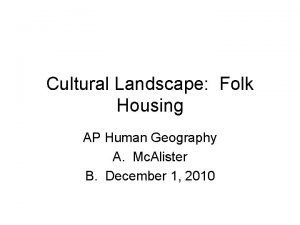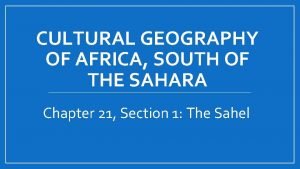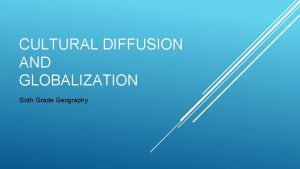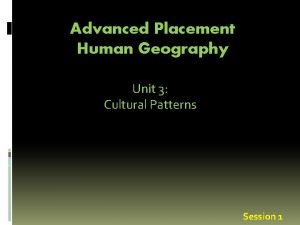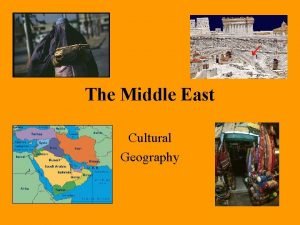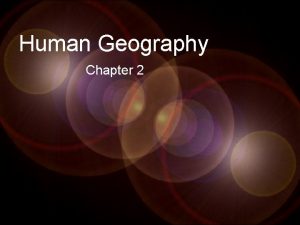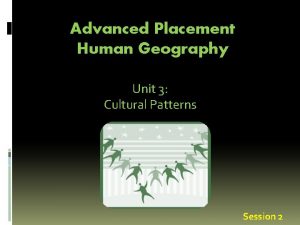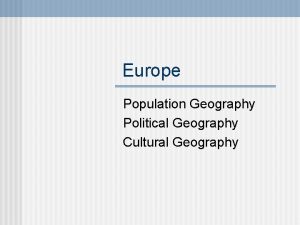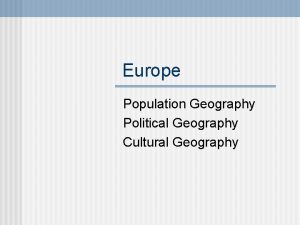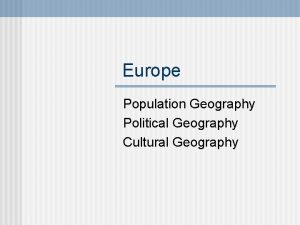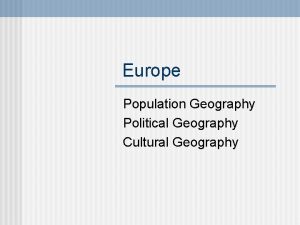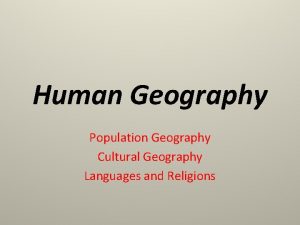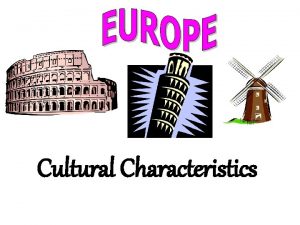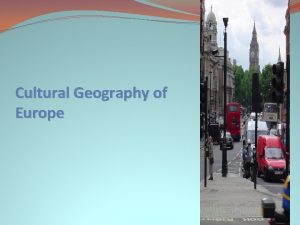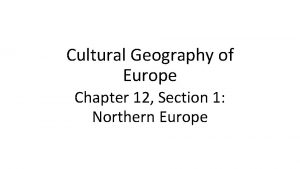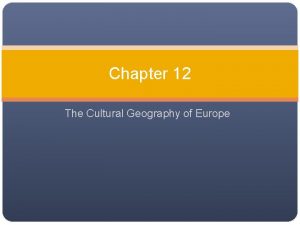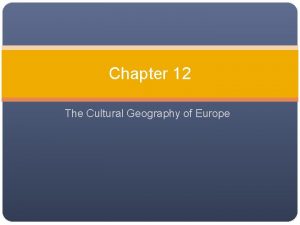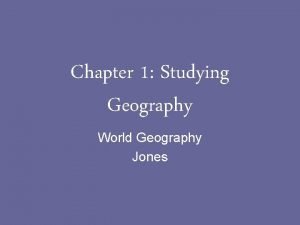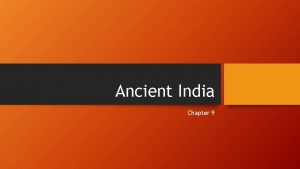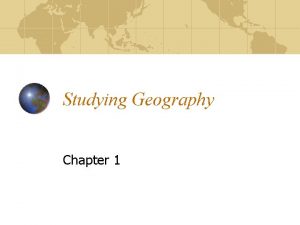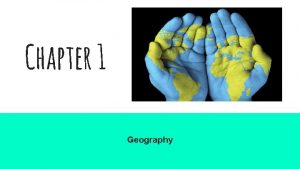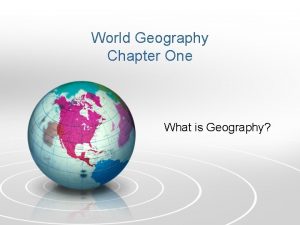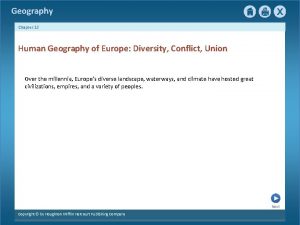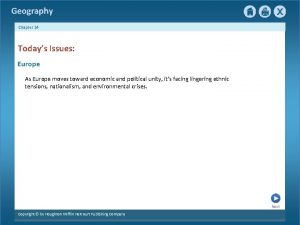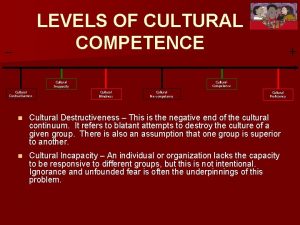Cultural Geography of Europe Chapter 12 Section 1












































- Slides: 44

Cultural Geography of Europe Chapter 12, Section 1: Northern Europe

Important Vocabulary • Immigrant: one that moves from one country to another. • Refugee: people who flee to another country for safety. • Middle Ages: period between ancient and modern times – 500 to 1500 AD. • Feudalism: a system in which monarchs or lords gave land to nobles in return for pledges of loyalty. • Reformation: a religious movement in the 1500 s that lessened the power of the Roman Catholic Church and introduced Protestantism to Europe.

Vocabulary (Cont’d) • Enlightenment: a movement to value reason and question tradition. • Industrial Revolution: transformed manufacturing by replacing human labor with machines. • Industrial Capitalism: an economic system in which owners used profits to expand their business. • Communism: a belief calling for economic equality and ownership of resources by the workers.

Vocabulary (Cont’d) • Cold War: a power struggle between the Soviet-controlled communist world and the American-led non-communist world. • European Union: a union which’s goal is to allow goods, services, and workers to move freely among its member nations. • Welfare State: a country that offers complete social welfare programs to its citizens. • Romanticism: a focus on emotions and the struggles of individuals.

Map of Northern Europe

The People • Swedes, Norwegians, and Danes have their own countries and languages, but share a Germanic heritage. • The United Kingdom consists of: England, Scotland, Wales, and Northern Ireland. • The British Isles were inhabited by Celtic peoples 2, 500 to 3, 000 years ago. Later followed by the Romans, Anglo. Saxons, and the Normans. • As of 2012, 61. 8 million people live in the United Kingdom.

Early Northern Europe • The Romans added Britain to its empire in 43 AD. • Rome abandoned Britain in the 400 s. • Germanic Angles and Saxons invaded. • The Normans (French) conquered Britain in 1066.

The Modern Era • Feudalism established. • German monk Martin Luther posted his 95 theses in 1517, erupting Protestant Reformation. • Enlightenment led to Glorious Revolution in England in 1688, power to Parliament.

The th 19 and th 20 Century • The Industrial Revolution transformed labor. • Industrial capitalism created. • Rise of Communism. • The World Wars left Europe in ruins. • 1945 -1991: The Cold War.

Culture • English, Swedish, Finnish, and Norwegian. • The region is predominately Protestant. • Highly educated area, literacy rate is near 100%. • English writings have shaped the world (William Shakespeare). • Danish artistic tradition: Hans Christian Anderson’s fairy tales. • Soccer, cricket, and hockey are popular sports.

Cultural Geography of Europe Chapter 12, Section 2: Western Europe

Important Vocabulary • Guest Worker: foreigners who work on a temporary basis in a country other than ones in which they are citizens. • Crusades: a series of religious wars (1, 000 s AD) to win Palestine (Israel) from Muslim control. • Reparations: payments for war damages. Ex: Germany after World War I. • Holocaust: the mass-murder of over 6 million Jews. • Realism: accurately depicting the details of everyday life. • Impressionist: one who makes impressions of the natural world.

Map of Western Europe

The People • Germany’s population is 82 million. Most populous in Europe. • Migration has been to urban areas. • Many guest workers in Germany and Belgium since World War II. • Paris: France’s capital and Western Europe’s cultural and economic center. • Brussels: Belgium’s capital and the European Union’s administrative center. • Amsterdam: Holland’s capital and known for its arts, global trade, and tolerance.

Antiquity • Basque, Celtic, and Frisian peoples were early inhabitants. • Caesar conquered Gaul in 52 BC. • Roman Empire fell in 476. • The Franks then came and adopted Christianity.

The Middle Ages • Frankish ruler Charlemagne (768 -814) brought feudalism. • The Holy Roman Empire (962 -1806): power struggles and corruption. • During the 1400 s, the Renaissance spread Greco. Roman cultures.

The Modern Era • The Reformation had some support. • France emerged as a power from the Thirty Years’ War (1618 -1648). • The French Revolution in 1789. Enlightenment ideals. • Prussia became powerful during the mid-1800 s. • German unification in 1871.

The World Wars • Assassination of Archduke Franz Ferdinand led to WWI in 1914. • Allies victorious in 1918. Germany assigned blame. • Nazi Germany invasion of Poland in 1939 started WWII. • Nazis defeated in 1945.

Cold War & European Union • Germany divided after WWII. • Berlin Wall fell in 1989. • Germany unified in 1990. • Co-operation of Western European nations led to the European Union in the 1990 s.

Culture • Western Europeans have pioneered the arts, education, and music. • The main languages in this region are French, German, and Dutch. • The majority are Roman Catholic. • The literary rate in the region is 98 -100%. Compulsory education. • Government-funded welfare and healthcare systems. • Living standards are high. • Declining birthrates and an aging population. • Popular activities: soccer, tennis, traveling, walking, and hiking.

Influential Sports Figures Switzerland’s Roger Federer Belgium’s Eden Hazard

Cultural Geography of Europe Chapter 12, Section 3: Southern Europe

Important Vocabulary • City-State: separate communities linked by language and culture. Ex: Ancient Greece – Athens and Sparta. • Renaissance: a period of Europe’s artistic and intellectual achievement. Began in 1300 s Italy.

Map of Southern Europe

The People • Greeks trace their roots to Minoans and Mycenaeans. Athens: Greek capital and center of ancient civilization. • Italians are descendants from ancient Etruscans, the Romans, and other groups. • Italy’s population is 60. 3 million people. Rome: Italian capital and popular tourism and commercial center. • Milan: Italy’s leading financial and commercial center. Venice: known for its beautiful canals. • Vatican City is located in Rome. Home of the Roman Catholic Church.

The People (Cont’d) • Spain’s descendants are ancient Iberians and Catalans. • Madrid: Spanish capital and artistic and financial center. • Portugal’s capital is Lisbon. • Millions of Southern Europeans immigrated to the Americas. • Many people are moving to urban areas.

Ancient Greece • Height of Ancient Greek civilization: 400300 BC. • Athens – introduced democracy. • Sparta – art of discipline and warfare.

Ancient Rome • The Roman Republic (509 -27 BC). • The Roman Empire (27 BC-476 AD). Adopted Christianity. • Germanic forces sacked Rome. • Eastern half survived as the Byzantine Empire until 1453. Its capital was Constantinople.

The Roman Empire

Post-Rome • Renaissance began in Italy in 1300 s, sparking artistic and intellectual achievements. • Italian city-states were rich and vibrant: Venice, Florence, Pisa, Genoa, and Milan.

The th 19 & Early th 20 Century • Italian unification in 1861. • Greece gained its independence from Ottoman Empire in 1821. • Both nations were damaged from the World Wars.

European Union • Greece experienced military coups and a military dictatorship from 1967 to 1974. • Italy and Greece are EU members. • Both have democraticallyelected gov’ts.

Culture • Ancient Greek and Roman architectural developments. • The world’s greatest arts from Leonardo Da Vinci and Michelangelo. • The main languages are Italian, Spanish, Portuguese; Greek. • The majority are Roman Catholic. Greeks are Eastern Orthodox.

Culture (Cont’d) • The literary rate is 95%. • Government-funded welfare and healthcare systems. Effectiveness varies. • Popular activities: soccer, basketball, bullfighting, and family celebrations.

Cultural Geography of Europe Chapter 12, Section 4: Eastern Europe

Important Vocabulary • Balkanization: the division of a region into smaller regions that are often hostile with each other. • Ethnic Cleansing: the expelling or killing of rival ethnic groups.

Map of Eastern Europe

The People • Most Eastern Europeans are ethnically Slavic. Slavs are decedents from Indo-Europeans who migrated from Asia. • East Slavs: Ukrainians, Russians, and Belarusians. • West Slavs: Poles, Czechs, and Slovaks. • South Slavs: Serbs, Croats, Slovenes, and Macedonians. • Former Yugoslavia: Serbia, Montenegro, Bosnia and Herzegovina, Croatia, Slovenia, Macedonia, and Kosovo.

The People (Cont’d) • Ukraine is the most populous country with 46 million people. • Many have emigrated for economic and political reasons, escaping Soviet control during the Cold War. • Industrialization in the 1900 s urbanized the region. • Great revival since the collapse of the Soviet Union. • The Hungarian capital of Budapest: thriving business and cultural area.

Early Civilizations • Early Slavs lived amongst Celtic and Germanic peoples. • Between 400 -700, Slavs moved west and south. • Slavic groups established states in Croatia, Serbia, and Slovenia. • East Slavs settled in Belarus and Ukraine.

Age of Empires • The Byzantine Empire influenced the region. • Eastern Orthodoxy spread. • The Ottomans conquered Byzantium in 1453 and controlled the area until its dissolution in 1922.

The Iron Curtain • Eastern Europe experienced power struggles and ethnic divisions. • Yugoslavia formed in 1918. • Eastern European nations fell under Soviet control. • Cold War: Communist east vs. Democratic west.

Fall of Communism • Revolts against Communism from the 1950 s to 1980 s. • The Communist gov’ts collapsed in 1989. • Balkan Wars erupted in the 1990 s, end of Yugoslavia. • Democratic free elections, market economies, and EU membership.

Culture • The common Slavic languages are Polish and Czech. Also Baltic languages. • Roman Catholicism, Eastern Orthodoxy, and Islam are common religions. • High literacy rates. • Challenges in transitioning to democracy and healthcare funding. • Folk music is important to Slavic culture. • High value for writing – Franz Kafka. • Small family units. • Sports and physical education programs still exist from Soviet era.
 Vocabulary activity 12 cultural geography of europe
Vocabulary activity 12 cultural geography of europe Definition of eastern europe
Definition of eastern europe Chapter 13 human geography of europe
Chapter 13 human geography of europe Vocabulary activity 15 cultural geography of russia
Vocabulary activity 15 cultural geography of russia Cultural geography of latin america
Cultural geography of latin america The enlightenment in europe chapter 6 section 2
The enlightenment in europe chapter 6 section 2 The enlightenment in europe chapter 22 section 2
The enlightenment in europe chapter 22 section 2 Feudalism in europe chapter 13 section 2
Feudalism in europe chapter 13 section 2 14 points of fascism
14 points of fascism Chapter 31 fascism rises in europe
Chapter 31 fascism rises in europe Chapter 29 section 2 europe plunges into war
Chapter 29 section 2 europe plunges into war Europe plunges into war chapter 13 section 2
Europe plunges into war chapter 13 section 2 Chapter 23 section 1 war breaks out in europe
Chapter 23 section 1 war breaks out in europe Chapter 22 section 2 the enlightenment in europe
Chapter 22 section 2 the enlightenment in europe Chapter 13 section 1 mediterranean europe
Chapter 13 section 1 mediterranean europe The enlightenment in europe chapter 22 section 2
The enlightenment in europe chapter 22 section 2 Chapter 17 section 2 the war for europe and north africa
Chapter 17 section 2 the war for europe and north africa Chapter 17 section 2 the war for europe and north africa
Chapter 17 section 2 the war for europe and north africa World history chapter 15 section 3
World history chapter 15 section 3 Fascism rises in europe
Fascism rises in europe Feudalism in europe chapter 13 section 2
Feudalism in europe chapter 13 section 2 Europe cultural map
Europe cultural map Chapter 16 world geography
Chapter 16 world geography World geography chapter 8 section 1
World geography chapter 8 section 1 World geography chapter 6 section 1
World geography chapter 6 section 1 Chapter 4 section 4 urban geography
Chapter 4 section 4 urban geography Chapter 4 section 2 population geography
Chapter 4 section 2 population geography Physical geography of europe
Physical geography of europe Ss6g7 brainwrinkle
Ss6g7 brainwrinkle Physical geography of northern europe
Physical geography of northern europe Shatter belt definition ap human geography
Shatter belt definition ap human geography Northwestern europe countries
Northwestern europe countries Distortion
Distortion The geometric arrangement of objects in space
The geometric arrangement of objects in space Cultural geography definition
Cultural geography definition Cultural divergence ap human geography definition
Cultural divergence ap human geography definition Ap human geography the cultural landscape
Ap human geography the cultural landscape Vocabulary activity 24 cultural geography of south asia
Vocabulary activity 24 cultural geography of south asia Cultural geography of africa
Cultural geography of africa Cultural diffusion geography definition
Cultural diffusion geography definition Artifact ap human geography examples
Artifact ap human geography examples Ethnic groups in the middle east
Ethnic groups in the middle east Cultural cohesion ap human geography
Cultural cohesion ap human geography Cultural homogenization ap human geography
Cultural homogenization ap human geography Cultural relativism ap human geography
Cultural relativism ap human geography

